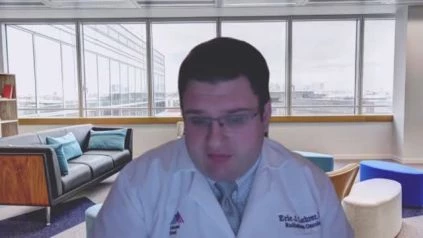Eric J. Lehrer MD, MS from Icahn School of Medicine at Mount Sinai speaks about the ASTRO Abstract 3419 The Development of Rib Fractures after Stereotactic Body Radiation Therapy to the Liver.
Link to the Poster –
https://astro.multilearning.com/astro/2020/annualmeeting/300363?evname=u42P5_6f3xRUr5o4erxthw&evsign=vlsxx9VM993-Uk5OhMekodzBeO0KlsCs8gN0Zh2nM5U
Body
Purpose / Objective(s): The well-described complication of thoracic stereotactic body radiation therapy (SBRT) is chest wall toxicity-pain and/or fracture. There is insufficient evidence on the occurrence and predictors of chest wall toxicity with SBRT to the liver for primary or metastatic lesions, although well defined for lung SBRT. In these patients, we tried to characterize the occurrence and predictors of rib fractures.
Methods/Materials: We retrospectively checked the reports of patients treated from 2014-2019 at a single NCI-designated cancer center with SBRT to the liver with IRB approval. Inclusion requirements included: (1) age of ⇠18 years; (2) SBRT identified as the delivery of at least 5 Gy per fraction in ⇠5 fractions; (3) at least one follow-up scan including chest wall and liver imaging of ⇠3 months. The a / b ratios of 10 Gy and 3 Gy were used to test the effect of dose as a continuous variable using the linear-quadratic model. In order to classify predictors for the production of rib fractures, univariate logistic regression was used, where the null hypothesis for p<0.05 was rejected. In R Studio Version 1.1.383, all statistical analyses were performed.
Findings: From 2014-2019, three hundred and eighty-one courses of liver SBRT were queried. Of these, 319 therapies for SBRT administered to 283 patients (204 male and 79 female) met the requirements for inclusion. The median age (range: 22-91 years) was 65 years. A median follow-up duration of 9.3 months was observed (range: 3-50 months). 81% were primary liver tumors and 19% were metastasized with respect to the primary site. The doses of SBRT varied from 60 Gy in five fractions to 30 Gy in five fractions. The most widely used doses were: 40 Gy for 5 fractions (29%), 45 Gy for 5 fractions (23%), 50 Gy for 5 fractions (18%), 35 Gy for 5 fractions (9%), 48 Gy for 3 fractions (8%), and 30 Gy for 5 fractions (5%). A total of 17 patients (6 percent) had rib fractures at least 3 months after completion of SBRT in the liver. Three (17.6 percent) and one (6 percent) of these patients received two and three courses of liver SBRT, respectively. Female gender (odds ratio [OR]: 3.7; 95 % confidence interval [CI]: 1.41-10.02; p=0.008), BED3 Gy (OR: 1.01; 1.00-1.01; p=0.05) and BED10 Gy (OR: 1.02; 95 % CI: 1.00-1.04; p=0.047) were correlated with the development of rib fractures with logistic regression. The development of rib fractures was not correlated with undergoing more than one course of SBRT to the liver (OR: 1.32; 95 % CI: 0.41-3.63; p=0.61) and administration of 3 fractions versus 5 fractions (OR: 1.98; 95 % CI: 0.44-6.57; p=0.31).
Outcome: The rate of rib fractures remains poor at approximately 5 percent after liver SBRT. This risk seems to be increased by the female gender and rising BED. In order to better define this risk, future research will attempt to further characterize dosimetric parameters.

